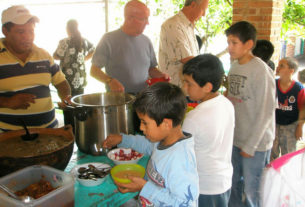Liberation theology didn’t begin with the Berrigan brothers or Bishop Ruiz. As far back as the l5th and l6th centuries, a remarkable man devoted the greater part of his 92 years on earth to ameliorating the lot of non-Caucasian people who lived in the vast Spanish empire. First known as a protector of Indians, he also became an advocate of black Africans who had been brought over by the Spaniards as slaves.
Las Casas was born at Seville in 1474. His father, of humble origin, could accurately be described as a nouveau riche. A common soldier under Columbus in his first voyage to the New World, he acquired enough wealth in the Indies to send his son to the prestigious University of Salamanca. For one who attained such prominence as a cleric, Bartolomé was rather tardy in taking religious orders. Though he studied both divinity and law, he took only a law degree when he completed his studies in 1498. In 1502 he accompanied the conquistador Gonzalo Fernández de Oviedo to the New World in what was then the greatest armada ever sent out from Spain.
In 1510, at age 36, Las Casas finally entered the priesthood. Ordained at Santo Domingo, capital of Hispaniola, he was the first priest ever to be consecrated in the colonies. The following year he accompanied the expedition that set forth from Hispaniola to occupy Cuba.
It was there that Las Casas first began to gain his reputation as a protector of the Indians. Leading opposition forces against the Spanish invasion was a chief named Hatuey. Captured, he was sentenced by the governor, Diego Velázquez, to be burned alive. Though Las Casas intervened in Hatuey’s behalf, he was overruled by the governor. But he had one consolation: Hatuey’s death gave him vivid material for his exposé of Spanish cruelty toward the Indians. In his Brief Account of the Destruction of the Indies, Las Casas relates that Hatuey was given a chance to embrace christianity before being burned so that his soul might go to heaven. The condemned chief asked if he would find the white man there. Told he would, he made this poignant reply: “Then I will not be a Christian, for I would not again go to a place where I must find men so cruel!”
This experience launched Las Casas on his lifelong crusade against mistreatment of Indians, as exemplified by two institutions known as the encomienda and the repartimiento. The former referred to lands “commended” to settlers and the latter to the requirement that Indians work these lands for little or no pay and frequently under the lash.
In 1516 Las Casas returned to Spain to plead the Indians’ case with King Ferdinand V. On arrival, he learned that the king had died and that his grandson and successor, Charles V, was out of the country. Fortunately, he found an ally in the regent, Cardinal Francisco Jiménez y Cisneros. Jiménez named him “Protector of the Indies” and, in 1520, authorized him to found a model colony in Santo Domingo. That the effort failed was hardly the fault of Las Casas. The Indians in the designated area, who had been feuding with the Spanish settlers, found themselves the target of a punitive expedition that arrived at the same time as Las Casas. Discouraged, he took refuge in a monastery run by Dominicans, an order he eventually joined.
But such an indomitable spirit could not be quenched for long. Following service in New Spain (Mexico), Nicaragua, Peru and Guatemala, he obtained an audience with Charles V. The result of that meeting was promulgation of the Nuevas Leyes de 1542, which dealt a severe blow to the encomienda. Unfortunately, these laws were repeatedly flouted by greedy settlers.
Though Las Casas supported the importation of blacks to the New World, he heatedly denied accusations that he was simply substituting one form of slavery for another. He wanted the blacks as free laborers, not slaves, and he insisted that “the same law (of 1542) applies equally to the Negro as to the Indian.”
Las Casas was almost as well-known a writer as he was an activist humanitarian. His most celebrated work was the magisterial three-volume Hístory of the Indies; among other writings were The Only Way to Bring People to Relígion and Treatises, Letters and Memoirs.
There are remarkable parallels between the careers in Chiapas of Las Casas and Ruiz, his latter-day spiritual descendant. Turning down the bishopric of Cuzco, Peru, Las Casas came to Chiapas in 1544, at age 70. William Prescott, leading 19 century historian of the conquest of Mexico, writes as follows: “The colonists looked on his coming with apprehension… everywhere he was received with coldness… yet he showed no disposition to conciliate his opponents… (he) outraged the plantees” and “incurred the disapprobation of his own brethren in the Church.”
Finally, fearing for his life, the 73-year-old bishop returned to Spain in 1547. He never returned to the New World. But he had ready access to court, living in Madrid and using his favor in royal circles to act as a gadfly. He never abandoned his single-minded crusade to help the Indian and in 1550 organizad a meeting of high civil and ecclesiastical authorities to consider the treatment of indigenous peoples in the Americas. He died in 1566, at the convent of Santa María de Atocha in Madrid.
This premature liberation theologian resembles both the historical Englishman, Sir Thomas More (author of Utopia who paid for his idealism with his life) and the fictional Spaniard Don Quixote. The Candide-like optimism of Don Bartolomé and his schemes for utopian settlements were ridiculed by hard-boiled Spanish captains in the tradition of Cortés, whom Las Casas despised as a vulgar adventurer. Though considered a failure in his lifetime, he left a legacy of humanitarian thinking behind him that would inspire Indian emancipation movements from the Rio Grande to Tierra del Fuego.

